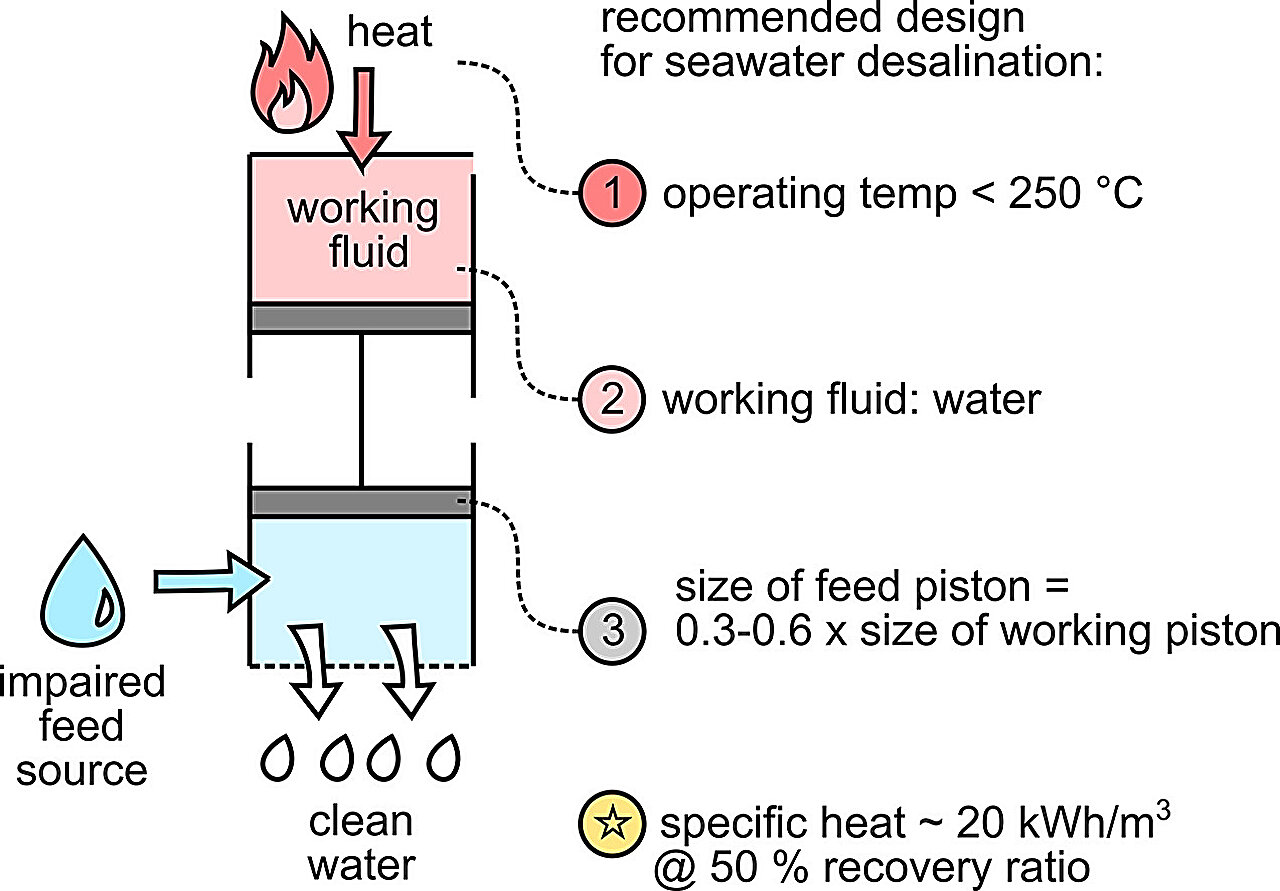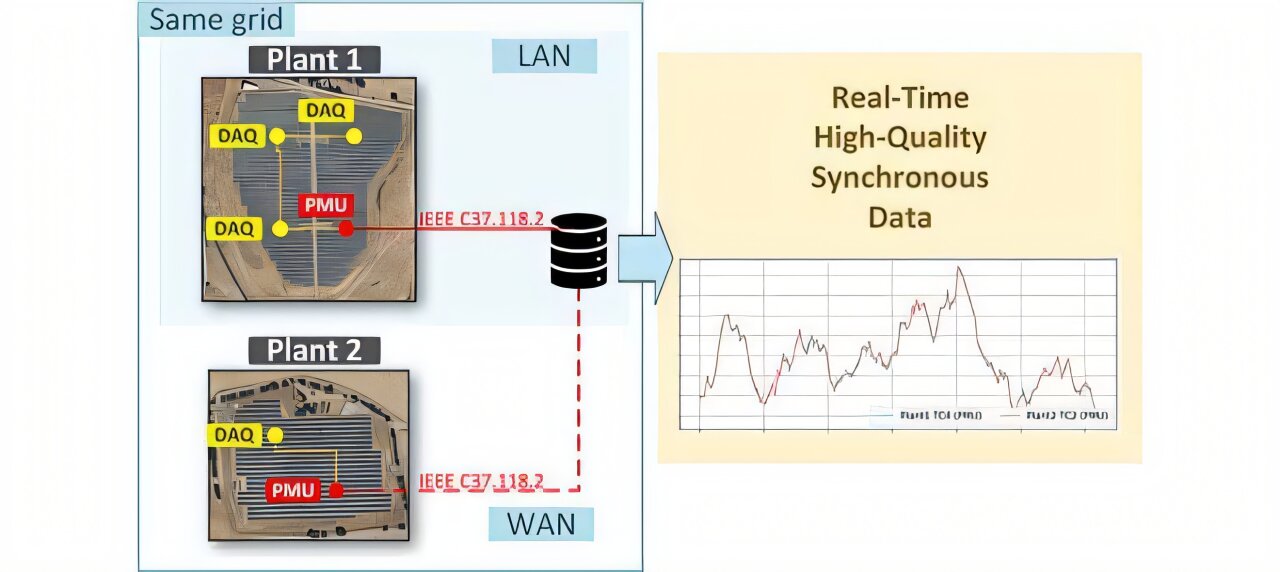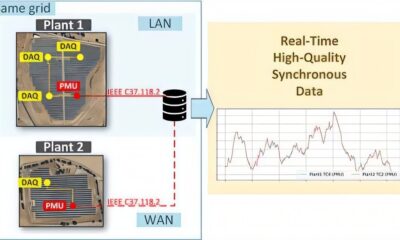Tech
Low-grade heat from renewable sources could be used to desalinate water

A McGill University-led research team has demonstrated the feasibility of a sustainable and cost-effective way to desalinate seawater. The method—thermally driven reverse osmosis (TDRO)—uses a piston-based system powered by low-grade heat from solar thermal, geothermal heat and other sources of renewable energy to produce fresh water.
Though previous research showed promise, this study is the first to analyze TDRO’s thermodynamic limits. The results have brought researchers closer to realizing the technology which could improve access to water and increase the sustainability of infrastructure.
“Most desalination is done by reverse osmosis, which uses electricity to drive water through a membrane,” said Jonathan Maisonneuve, study co-author and Associate Professor of Bioresource Engineering.
“The challenge with using heat is that it takes a lot of it to do what you could with a little bit of electricity. So, if we can find a way to harness existing heat from renewable sources, that could be very advantageous, because it’s so abundant,” Maisonneuve said.
“Thermally driven reverse osmosis: thermodynamics of a novel process that uses heat for desalination and water purification,” by Saber Khanmohammadi, Sanjana Yagnambhatt, Dan DelVescovo and Jonathan Maisonneuve, was published in Desalination on Oct. 15, 2025.
Addressing the water and energy crises
Electricity-based desalination, which is often inaccessible in remote areas, requires about one to four kilowatt hours (kWh) to produce one cubic meter of fresh water.
According to the researchers’ analysis, which optimized several elements of a design proposed by MIT researcher Peter Godart, TDRO would require 20 kWh per cubic meter.
“There’s still a big difference when you compare it to one to four kWh, but because heat is cheaper than electricity, we don’t have to totally close that gap,” Maisonneuve said.
TDRO works by heating and cooling a small amount of fluid in a sealed chamber, known as the working fluid. This temperature fluctuation expands the working fluid, causing it to drive a piston to push seawater through a reverse osmosis membrane—effectively combining a thermodynamic cycle with water purification.
By studying and optimizing the ratio of working fluid to seawater fluid, as well as the piston sizes, the researchers demonstrated that TDRO has better performance potential than previously thought. The method also compares well against existing thermal desalination technologies, but they say further study is required.
“Next, we need to model it in detail, see how quickly the system can operate and introduce a number of non-ideal effects, such as heat loss through the environment,” Maisonneuve said.
More information:
Saber Khanmohammadi et al, Thermally driven reverse osmosis: thermodynamics of a novel process that uses heat for desalination and water purification, Desalination (2025). DOI: 10.1016/j.desal.2025.119103
Citation:
Low-grade heat from renewable sources could be used to desalinate water (2025, November 14)
retrieved 14 November 2025
from https://techxplore.com/news/2025-11-grade-renewable-sources-desalinate.html
This document is subject to copyright. Apart from any fair dealing for the purpose of private study or research, no
part may be reproduced without the written permission. The content is provided for information purposes only.
Tech
DOJ Issued Seizure Warrant to Starlink Over Satellite Internet Systems Used at Scam Compound

As scam compounds in Southeast Asia continue to rake in billions of dollars in stolen funds from victims around the world, United States law enforcement aims to cut scammers off at the source by issuing seizure warrants for Starlink satellite internet terminals that provide cybercriminals with connectivity. Two US warrants and affidavits seen by WIRED detail how Starlink devices are allegedly being used by cybercriminals running scam compounds in Myanmar.
One warrant, issued on Wednesday by US Magistrate Judge G. Michael Harvey, authorized the seizure of nine Starlink terminals and two Starlink accounts allegedly used in scam compounds in Payathonzu, near Three Pagodas Pass at the Myanmar-Thai border. A linked affidavit, written by FBI investigators, claims that the Starlink devices and accounts played a “substantial role” in an alleged money laundering and wire fraud operation targeting US citizens—saying Starlink parent company SpaceX should “disable service” to the devices. It also claims that at least 26 Starlink dishes appeared to be on the roofs of several buildings making up one scam center of several in the Three Pagodas Pass area.
The second warrant and affidavit—which was not issued to Starlink but focused on seizing websites used in scamming—also claims that “at least” 79 Starlink dishes appear on the roofs of buildings at the notorious Tai Chang compound in Myanmar, which US officials say is controlled by the Democratic Karen Benevolent Army, an armed group in Myanmar which was sanctioned by the US government this week. The warrant was signed on Monday by US Magistrate Judge Matthew J. Sharbaugh.
Both sets of legal documents cite a WIRED investigation from earlier this year, which revealed that scam compounds in Myanmar have been using Starlink for internet access. Starlink, which is owned and operated by Elon Musk’s SpaceX, is a high-speed satellite internet service available in more than 150 countries around the world.
The action comes as part of a new US law enforcement initiative known as the District of Columbia Scam Center Strike Force that was announced by the Justice Department, FBI, and Secret Service on Wednesday. The effort aims to combat cryptocurrency scams targeting Americans, specifically fraud that originates from an ecosystem of systematized scamming that has evolved in multiple Southeast Asian countries and is often linked to Chinese organized crime. The “Strike Force” is already operational and the Justice Department says it has seized roughly $400 million in cryptocurrency so far that was stolen in scams.
“The Department of Justice will not stand by while Chinese organized crime victimizes Americans and bleeds dry the hard earned investments of American citizens,” Jeanine Pirro, the US Attorney for the District of Columbia, said in a press conference. “We have seized websites being used by these compounds in Southeast Asia that are used to victimize Americans. We are seeking warrants to see satellite terminals and accounts being used by the perpetrators to connect to the internet.”
Tech
‘Big brother’ system designed to monitor solar plants

Using a network of synchronized sensors, a new system provides energy and meteorological data every tenth of a second to more accurately predict the performance of solar plants.
Solar plants do not always provide energy. Rather, they do so only when they can, as they depend on the weather. A single cloud, for example, can cause a drop in production.
To address the uncertainty inherent in solar plant operations, the Instrumentation and Industrial Electronics research group at the University of Cordoba has developed a new monitoring system that uses a variety of sensors to provide more detailed, precise, and synchronized information about solar plant performance. This is a Big Brother-style monitoring system designed not only to observe and predict these plants’ performance, but also to adjust the auction that sets energy prices to more realistic conditions.
The research is published in the IEEE Sensors Journal.
The goal was to analyze how solar plants generate energy in relation to weather conditions. To achieve this, the team utilized devices that have been on the market for several years, to which they applied new implementations. Thanks to these devices, the collection of equipment, which they have named Extended Phasor Measurement Units, can gather energy (such as current, voltage, and frequency) and meteorological (such as solar radiation) data.

The key is that this data is collected every tenth of a second, in great detail; so detailed, in fact, that they generate around 2 to 3 gigabytes of data each month. Furthermore, because the devices are synchronized with each other and located in different areas, including nearby solar plants, the information they provide allows us to see what has happened, and anticipate what is going to happen.
As UCO researcher Víctor Pallares López explained, “It’s about closely monitoring the systems to gather as much information as possible and being able to react to any negative effects that could affect the stability of the electrical grid.”
The more closely they are monitored, the sooner action can be taken to isolate the system from potential disturbances by disconnecting it and preventing their spread.
The sensors have been fine-tuned, tested in both the laboratory and at two Pozoblanco plants, and all the errors have been reviewed, so the team is now immersed in the second phase of the project: analyzing all the data generated.
This work is currently being conducted as part of the national project “Edge management of photovoltaic plants based on an analytical architecture with near-perfect temporal precision,” with reference PID2024-158091OB-C21.
More information:
Victoria Arenas-Ramos et al, Implementation and Characterization of a High-Precision Monitoring System for Photovoltaic Power Plants Using Self-Made Phasor Measurement Units, IEEE Sensors Journal (2025). DOI: 10.1109/jsen.2025.3598820
Citation:
‘Big brother’ system designed to monitor solar plants (2025, November 14)
retrieved 14 November 2025
from https://techxplore.com/news/2025-11-big-brother-solar.html
This document is subject to copyright. Apart from any fair dealing for the purpose of private study or research, no
part may be reproduced without the written permission. The content is provided for information purposes only.
Tech
Weight-Loss Drug Zepbound Is Being Tested as a Treatment for Long Covid

Obesity wonder drugs Wegovy and Zepbound are already showing that they can reduce the risk of cardiovascular and chronic kidney disease in addition to helping people lose weight. Now, a US-wide trial will test whether tirzepatide, the active ingredient in Zepbound, may be an effective treatment for people with long Covid.
Part of a class of drugs known as GLP-1s, tirzepatide acts on receptors in the gut and the brain to regulate appetite. As a result, people shed pounds by eating less. But decreased body weight doesn’t fully explain the positive effects on the heart and kidney. Mounting evidence suggests that the drugs have a broad anti-inflammatory effect on the body—a mechanism that’s of interest for treating long Covid.
As many as 20 million people in the US have experienced long Covid, a chronic condition that lasts for at least three months after an initial infection. While more than 200 symptoms of long Covid have been documented, some of the most common include coughing, shortness of breath, brain fog, fatigue, mood changes, trouble sleeping, and body aches.
Scientists still don’t fully understand how and why long Covid occurs, but they’ve found persistent inflammation in many patients. This chronic inflammation may be caused by lingering traces of virus in the body or by misdirected antibodies, known as autoantibodies, that attack a person’s own cells and tissues. The hope is that tirzepatide could tamp down this inflammation to improve patients’ symptoms.
“The rationale for a GLP-1 drug is its powerful body-wide and brain anti-inflammatory properties,” says Eric Topol, a cardiologist and the director of the La Jolla, California-based Scripps Research Translational Institute, which is sponsoring the trial.
Scripps researchers are recruiting 1,000 people across the country who are 18 years of age or older and have medical documentation of long Covid. Unlike most medical studies, which typically require multiple in-person visits, the Scripps trial is fully remote. Participants will be randomized to receive either tirzepatide or a placebo by mail and will take it for a year. They’ll receive a fitness tracker so that researchers can measure their step count, an important indicator of fatigue. Participants will also get a smart scale and will weigh in regularly. Since GLP-1s are used for weight management, study investigators want to make sure participants don’t lose too much weight during the trial.
Julia Moore Vogel, coprincipal investigator of the trial who herself has long Covid, says the remote design of the trial was intentional. “For the long Covid population, it’s so crucial, because if you’re requiring people to come into a clinic, you’re systematically excluding the most severely affected folks who are housebound or bedbound. It was really important to us to make sure that those people are included.”
-

 Entertainment6 days ago
Entertainment6 days agoChina unveils£5.4 bn Fujian, its most advanced aircraft carrier yet
-

 Tech1 week ago
Tech1 week ago‘Vibe coding’ named word of the year by Collins dictionary
-

 Business1 week ago
Business1 week agoBudget tax hikes could see food prices soar, major supermarket boss warns
-

 Entertainment7 days ago
Entertainment7 days agoRobert Pattinson jokes about competing with Gen Z
-

 Politics7 days ago
Politics7 days agoIDF lawyers warned of possible Gaza war crimes: US intel findings
-

 Entertainment1 week ago
Entertainment1 week agoMeghan Markle returns to acting in star-studded film: details inside
-

 Business1 week ago
Business1 week agoFM asks banks to ensure staff speak local language – The Times of India
-

 Tech7 days ago
Tech7 days agoThe Government Shutdown Is a Ticking Cybersecurity Time Bomb


















